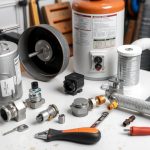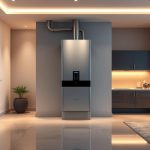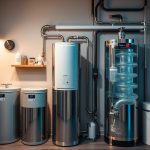I’ll never forget the day my nephew accidentally turned the shower handle all the way to hot. The piercing scream that followed haunts me. It was a stark reminder of how quickly a simple shower can become dangerous.
Every year, thousands of families face the risk of scalding from unregulated hot water. A hot water heater mixing valve is more than just a plumbing part. It’s a critical safety device that protects your loved ones from unexpected burns.
Water heater safety valve technology has come a long way. It offers homeowners powerful tools to prevent accidents. Whether you have young children, elderly family members, or just want to ensure home safety, a well-designed temperature control valve can make a big difference.
Key Takeaways
- Hot water mixing valves prevent dangerous scalding incidents
- Recommended water temperature is 120°F or lower
- Children and elderly are most vulnerable to hot water burns
- Professional installation ensures optimal safety
- Regular valve maintenance prevents accidents
What is a Hot Water Heater Mixing Valve?

Keeping water temperature safe and comfortable is key for your home. A water temperature regulating valve is vital for hot water systems. It ensures water is delivered safely and precisely across your home.
The thermostatic mixing valve is a smart protector of your home’s water temperature. It mixes hot and cold water streams to create the perfect water temperature. This helps prevent scalding risks in your home.
Definition and Core Function
A water temperature regulating valve, also known as an anti-scald valve, does several important things:
- It blends hot water from your heater with cold water.
- It keeps the water temperature consistent.
- It prevents dangerous temperature changes.
- It helps prevent burn hazards.
Importance in Hot Water Systems
The thermostatic mixing valve is essential in today’s water systems. Water heaters are set to high temperatures to kill harmful bacteria like Legionella. The mixing valve makes sure the water at your taps is safe, around 120 degrees Fahrenheit.
Water temperature can cause serious burns within seconds at extreme temperatures, making mixing valves an essential safety component.
Today’s anti-scald valves have advanced features. They include thermal disinfection and automatic shut-off if cold water supply fails. These features add extra protection for homeowners.
Benefits of Using a Mixing Valve
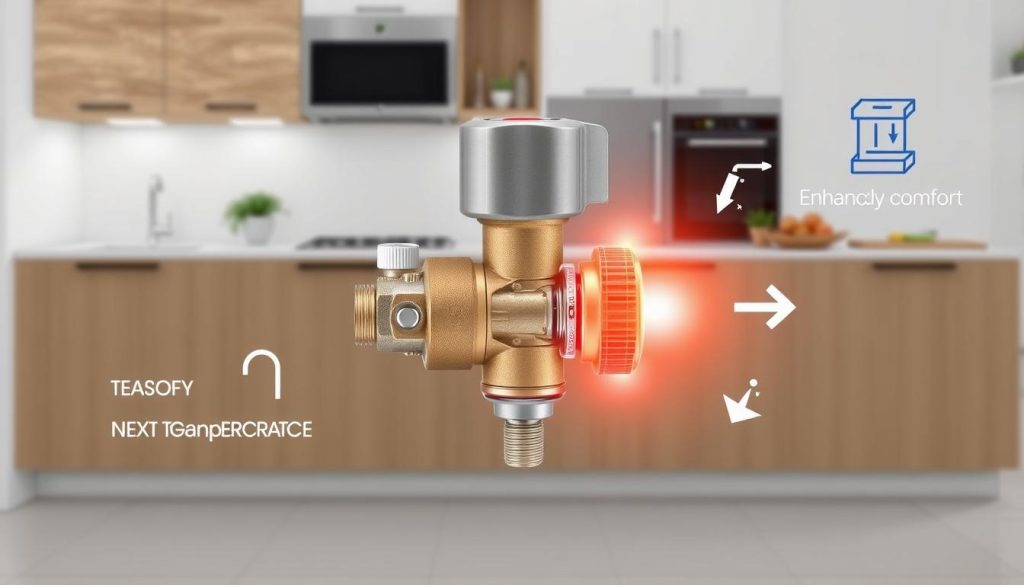
A hot water tempering valve brings many benefits to homeowners. It makes water systems safer and more comfortable. These devices balance safety, comfort, and efficiency in one.
Improved Safety Features
Water heater blending valves lower scalding risks by keeping water at the right temperature. They set the water to about 120 degrees Fahrenheit. This is much safer than the usual 140 degrees from water heaters.
- Prevents scalding for vulnerable populations
- Reduces risk of accidental burns
- Protects children and elderly from temperature fluctuations
Enhanced Comfort and Efficiency
Modern water heater blending valves offer unmatched comfort. They keep the water temperature steady. These devices also boost hot water capacity by up to 25% and save energy.
| Valve Type | Temperature Control | Energy Savings |
|---|---|---|
| Thermostatic Mixing Valve | 120°F Residential Setting | Up to 50% Reduction |
| Single-Control Valve | Residential Applications | 25% Hot Water Capacity Increase |
“A mixing valve transforms your water system from potentially dangerous to consistently safe and comfortable.” – Plumbing Safety Expert
Investing in a hot water tempering valve means investing in your family’s safety and comfort. These devices not only protect against scalding but also help make your home more energy-efficient.
How a Mixing Valve Works

Water temperature control is key in today’s plumbing systems. A temperature control valve is vital for safe and effective water temperature management. It’s used in homes and businesses.
The valve works by mixing hot and cold water streams. This creates a consistent and safe water temperature.
The Mechanism Explained
Thermostatic Mixing Valves (TMVs) have a special design. They ensure the water temperature is always right:
- They have separate inputs for hot and cold water.
- A mixing chamber combines the water streams.
- A thermostatic element adjusts the valve position.
- They have a fail-safe to prevent scalding.
Key Components
A temperature control valve has important parts:
| Component | Function |
|---|---|
| Valve Body | It houses the internal mechanisms. |
| Thermostatic Element | It changes size with water temperature. |
| Check Valves | They stop water from flowing the wrong way. |
| Adjustment Mechanism | It lets you set the exact temperature. |
“Precision in water temperature control is not just about comfort, it’s about safety.” – Plumbing Engineering Expert
Modern mixing valves always check the water temperature. They adjust it in real-time to keep it at the right setting, even when the input temperatures change.
Types of Hot Water Heater Mixing Valves

Hot water heater mixing valves are key in controlling water temperature. They help avoid scalding risks. Knowing the different types helps homeowners choose the best for their home’s safety and comfort.
Today’s water systems use three main types of hot water tempering valves. Each is made for a specific need in temperature control:
Thermostatic Mixing Valves
Thermostatic mixing valves offer the most precise temperature control. They use a temperature-sensitive element to adjust hot and cold water ratios. Key features include:
- Output temperature range between 85-180°F
- Maintains consistent water temperature within 2-3 degrees
- Ideal for shower and bathing fixtures
- Complies with ASSE Standard 1016 and 1070
Pressure-Balancing Valves
Pressure-balancing valves keep water temperature steady by balancing hot and cold water pressures. They stop sudden temperature changes, keeping users safe from scalding or cold shocks.
- Recommended for residential bathrooms
- Prevents temperature fluctuations during simultaneous water use
- More affordable compared to thermostatic options
Digital Mixing Valves
Digital mixing valves are the latest in water temperature management. They use electronic sensors and precise controls for unmatched accuracy in regulating water temperature.
- Provides real-time temperature monitoring
- Enables remote temperature adjustments
- Integrates with smart home systems
- Offers detailed performance analytics
“Selecting the right mixing valve is key for safety and comfort in your home’s water system.” – Water Safety Experts
Each type of hot water tempering valve has its own benefits. It’s important to think about your household’s needs when picking the best one.
Installation Considerations

Installing a hot water heater mixing valve needs careful planning and expertise. Homeowners must decide if they can do it themselves or need a professional. The right choice ensures your water heating system works well and safely.
DIY Installation vs. Professional Help
Some homeowners might think they can handle it, but professional installation is often better. Think about these points:
- How complex your water heater system is
- Your plumbing skills
- Local building codes
- Warranty issues
“Proper installation is key to preventing water damage and keeping your system efficient.”
Space Requirements for Mixing Valve Installation
Installing a hot water heater mixing valve needs the right space and placement. Experts suggest:
- Measuring the space near the water heater
- Ensuring easy access for maintenance
- Checking how close it is to electrical and plumbing connections
The installation process includes technical steps:
- Turning off water and power to the heater
- Using vinyl plumber’s tape on connections
- Securing flex lines
- Checking for leaks after installation
Tools like adjustable wrenches, pipe wrenches, and coupler fittings are needed. The aim is to create a safe, efficient system that prevents scalding and keeps water at the right temperature.
How to Maintain Your Mixing Valve
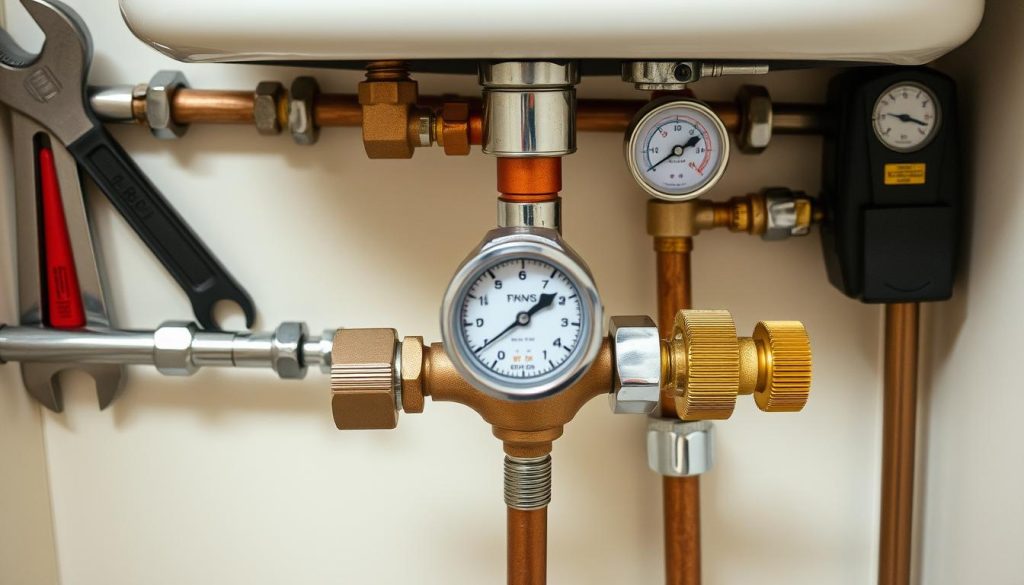
Keeping your temperature control valve in good shape is key. It makes sure your water heater works well and lasts longer. Regular care stops problems and keeps your water safe to drink.
Regular Inspection Tips
It’s important to check your water heater mixing valve often. Here’s what to look for:
- Examine valve connections for any leaks
- Make sure everything moves smoothly
- Use a thermometer to check the water temperature
- Watch for mineral buildup or rust
Cleaning and Maintenance Procedures
There are a few steps to keep your water heater blending valve in top shape:
- Turn off the water and power first
- Remove mineral deposits gently
- Use the right cleaner on valve parts
- Lubricate moving parts as the maker says
“Regular maintenance can prevent 90% of possible water heater valve failures.”
Experts say you should do these maintenance tasks:
| Component | Inspection Frequency | Action Required |
|---|---|---|
| External Valve Connections | Every 6 months | Visual check and tighten if needed |
| Internal Valve Mechanism | Annually | Deep clean and lubricate |
| Temperature Calibration | Annually | Check the temperature setting |
Pro tip: Always have the maker’s manual for your valve model handy.
Troubleshooting Common Issues

Hot water tempering valves can have problems that affect your home’s water system. Knowing these issues helps you fix them quickly. This way, you avoid bigger problems later.
Symptoms of a Malfunctioning Valve
It’s important to spot the signs of a failing anti-scald valve. This keeps your water safe. Look out for these key signs:
- Sudden temperature changes when you use the shower or sink
- Unexpectedly cold or scalding water without changing the setting
- Lower water pressure from your fixtures
- Water keeps getting hotter, using more energy
“Water over 140°F can burn your skin in under five minutes. So, keeping your valve working right is key for safety.”
Quick Fixes for Hot Water Mixing Valve Problems
Some issues with hot water valves can be fixed easily:
- Check and clean the valve parts for mineral buildup
- Make sure the hot and cold water connections are right
- Set the temperature to the recommended 120°F
- Look for any leaks or damage
If these steps don’t work, you might need a pro. Plumbers with the right licenses can fix complex problems. They make sure your water system is safe and works well.
Understanding Temperature Settings

Managing water temperature is key for home safety and comfort. A temperature control valve is vital for keeping water safe and efficient. It prevents dangers and makes sure your hot water works well.
Water temperature valves help keep water safe and comfy all year. Knowing how to set the right temperature is important. It keeps your family safe from harm.
Optimal Temperature Levels for Safety and Comfort
Finding the right hot water temperature is important. Experts say to keep it around 120°F (49°C). This keeps scalding risks low but water useful.
- Temperatures below 120°F may encourage bacterial growth
- Temperatures above 125°F significantly increase burn risks
- Vulnerable populations like children and elderly require extra caution
Seasonal Temperature Adjustments
Seasons change, and so should your water temperature. In winter, you might need warmer water. But in summer, cooler water is better.
| Season | Recommended Temperature | Rationale |
|---|---|---|
| Winter | 120-125°F | Higher heat retention |
| Summer | 115-120°F | Lower energy consumption |
“Precision in temperature control is the key to both safety and comfort in your home’s water heating system.” – Plumbing Safety Expert
Experts say to check your water temperature regulating valve often. This keeps it working right and safe.
Safety Regulations and Standards

Water heater safety standards are key to keeping homeowners safe. The plumbing world keeps getting better with new rules and tech. This helps protect us from dangers in hot water systems.
New safety standards are all about water heater safety valves and anti-scald valves. The American Society of Sanitary Engineering (ASSE) has set three new standards. These aim to control water temperature better and avoid dangers.
- ASSE 1082: Focused on steady-state flow performance
- ASSE 1084: Addressing plumbing fixture temperature requirements
- ASSE 1085: Designed for emergency fitting specifications
Existing Building Codes
Building codes in the US are getting stricter about water temperature safety. Key rules include:
- Limiting maximum water temperature to 120°F (49°C)
- Mandatory installation of anti-scald valves in new constructions
- Specific temperature controls for different applications
Compliance with Federal Standards
Federal rules aim to lower scalding risks and thermal shock. The Consumer Product Safety Commission has guidelines for water heater setups:
“Proper temperature control is essential to prevent serious burn injuries and ensure household safety.”
Important things to keep in mind for water heater safety valve installations are:
- Implementing check valve requirements
- Monitoring outlet temperatures
- Preventing bacterial growth
- Ensuring consistent water temperature
Safety experts say we should check mixing valves often. This keeps the system working well and avoids problems.
Signs of a Faulty Mixing Valve
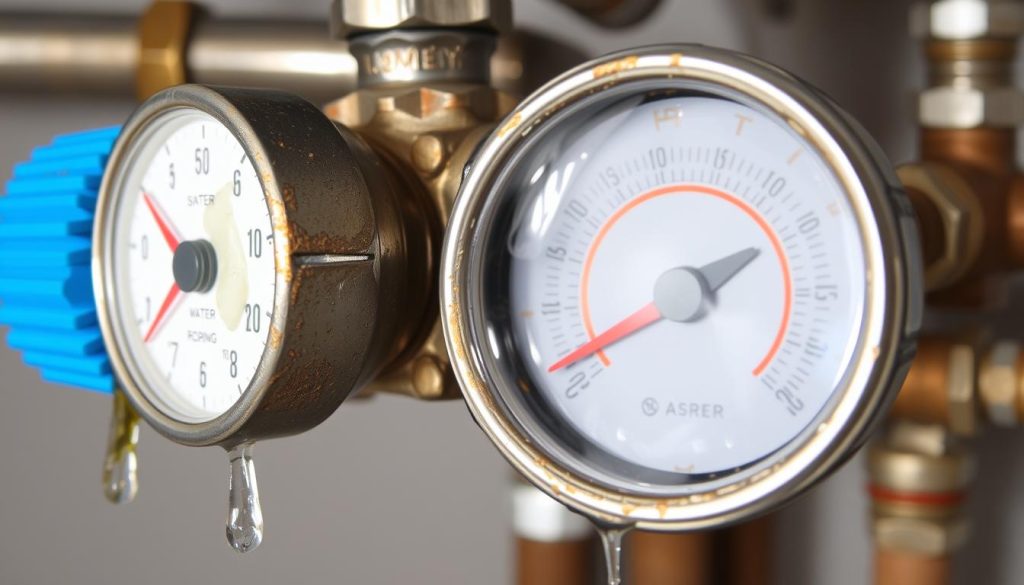
Spotting problems with your hot water heater mixing valve can avoid big repairs. Homeowners should watch for small signs that a thermostatic mixing valve might be failing.
Water systems face many challenges, with 60-70% of mixing valve issues affecting home comfort and safety. Knowing these warning signs is key to keeping your hot water system running well.
Dripping Water: A Critical Warning
Water dripping from your fixtures could mean a serious problem with the hot water heater mixing valve. Look out for:
- Continuous water leakage around valve connections
- Wet spots near plumbing fixtures
- Unexplained moisture around pipe connections
Inconsistent Water Temperature
Fluctuating water temperatures are another sign of a malfunctioning thermostatic mixing valve. You might notice:
- Sudden hot or cold water bursts during shower
- Unpredictable temperature changes
- Difficulty maintaining steady water temperature
Older homes with water heaters 15-20 years old are more likely to face mixing valve problems. Cold weather makes these issues worse, affecting 50-60% of cases.
“A faulty mixing valve isn’t just an inconvenience—it’s a safety risk for your household.” – Plumbing Experts Association
Additional Warning Signs
| Symptom | Potential Issue |
|---|---|
| Low water pressure | Potential valve blockage |
| Complete loss of hot water | Severe valve malfunction |
| Unusual noises | Internal valve component damage |
Prompt detection and professional assessment can prevent more extensive damage to your hot water system.
Comparing Mixing Valves and Anti-Scald Devices
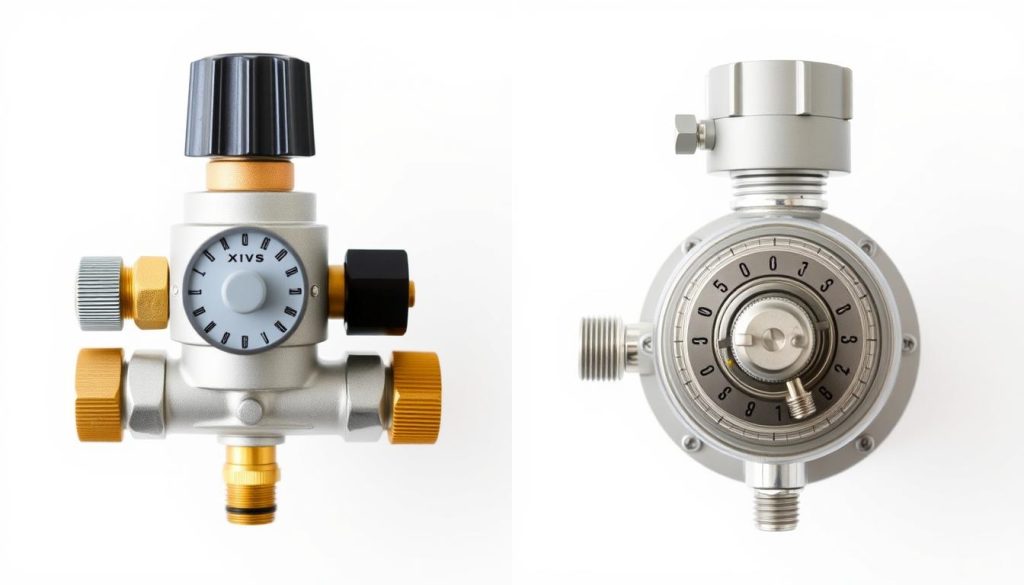
Keeping water safe is very important for homeowners and facility managers. Knowing the difference between mixing valves and anti-scald devices helps avoid scalding risks. It also ensures the water is at the right temperature.
Managing water temperature uses advanced technology to prevent burns and keep water comfortable. The temperature control valve and anti-scald valve work together. They protect users from dangerous water temperatures.
Key Differences
- Mixing valves mix hot and cold water for the perfect temperature
- Anti-scald devices stop scalding by reacting to sudden pressure changes
- Mixing valves are for many fixtures or whole water systems
- Anti-scald devices are for each fixture
When to Use Each
Choosing between a mixing valve and an anti-scald valve depends on your needs. Thermostatic mixing valves are great for places needing exact temperature control, like:
- Healthcare facilities
- Childcare centers
- Public shower facilities
- Industrial applications
“Understanding the right use for each valve is key to safety and function in different places.” – Plumbing Safety Expert
In homes, using both types of valves is best. Anti-scald devices are good for each fixture. A whole-house valve keeps the water temperature the same everywhere.
Most U.S. rules say water should be 120°F or less to avoid scalding. Anti-scald valves usually last five years and come with a 12-month warranty. They are a big part of keeping water safe.
Purchasing the Right Mixing Valve
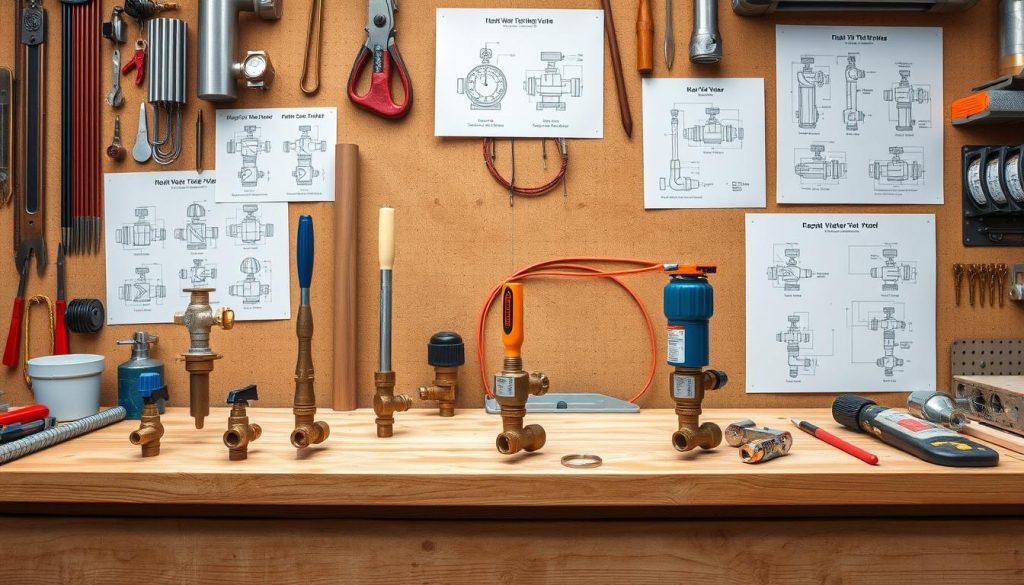
Choosing the right hot water heater mixing valve is important. It affects your home’s water safety, comfort, and energy use.
Critical Factors to Evaluate
When looking for a water heater blending valve, consider these key points:
- Valve size compatibility (most popular sizes are 1/2″ and 3/4″)
- Temperature range capabilities
- Material durability (brass is most common)
- Pressure handling capacity
- Installation requirements
Top Brands in the Market
Trusted brands offer reliable hot water heater mixing valves for homes and businesses:
| Brand | Specialty | Temperature Range |
|---|---|---|
| Honeywell | Precision temperature control | 30°C to 60°C |
| Watts | High-pressure systems | 80°F to 120°F |
| Cash Acme | Residential solutions | 50-55°C recommended |
| Leonard Valve | Commercial applications | Above 60°C for bacteria control |
“A well-chosen mixing valve isn’t just a component—it’s a critical safety investment for your home’s water system.”
The right mixing valve can prevent scalding. Most are set between 80°F and 120°F. Experts suggest keeping water at 120°F for safety and comfort.
Pro tip: Always consult a licensed plumber to ensure your mixing valve matches your specific system requirements and local building codes.
Cost Considerations
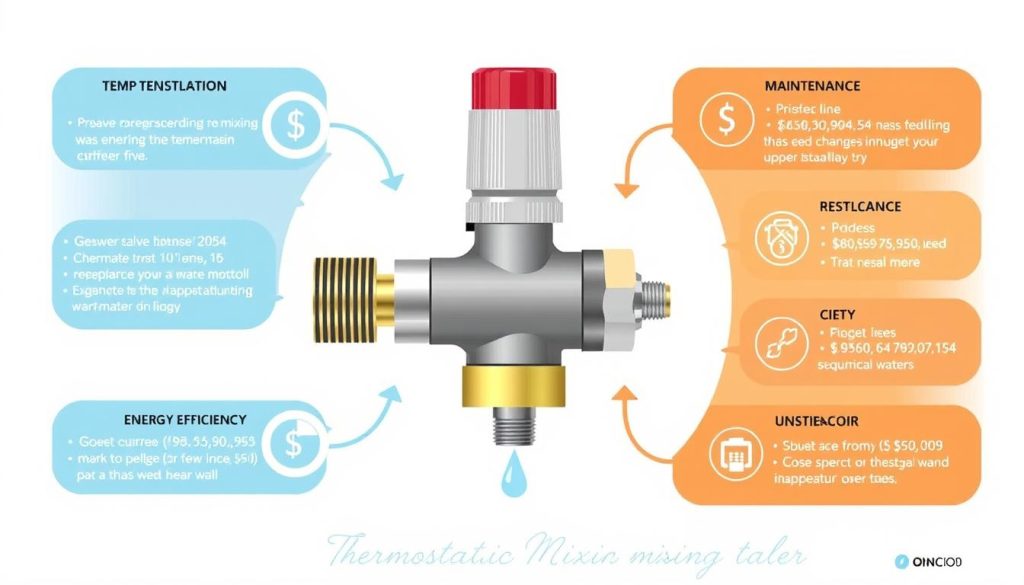
Buying a thermostatic mixing valve needs careful planning. The cost upfront might look high, but the long-term savings are worth it.
Initial Purchase Breakdown
The cost of a water temperature regulating valve varies a lot. Homeowners can expect to spend:
- Basic point-of-use valves: $50 – $200
- Mid-range whole-house systems: $200 – $500
- High-end professional models: $500 – $900
Long-Term Savings
Even though the initial cost is high, a good thermostatic mixing valve saves money in the long run:
- Energy efficiency improvements
- Less water waste
- Longer water heater life
“A smart choice in temperature control can cut energy costs by hundreds each year.”
Budget-Friendly Options
For those watching their budget, there are ways to save on a water temperature regulating valve:
- Look for local utility rebates
- Get quotes from different installers
- Try DIY installation for simple setups
Annual upkeep for a thermostatic mixing valve costs $100 to $200. It’s a small price for safe and comfortable water all year.
User Reviews and Experiences
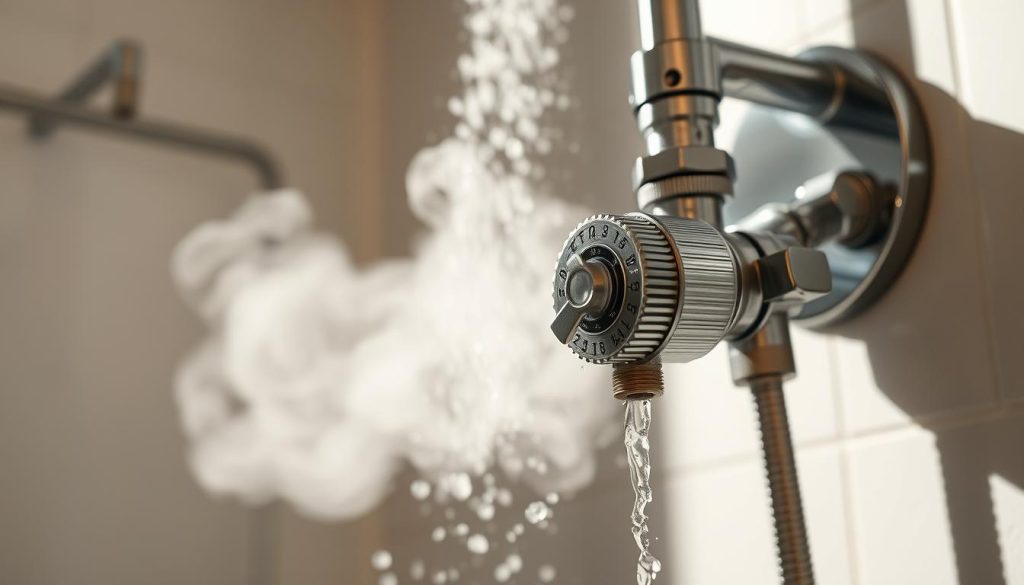
Looking into real-life experiences with hot water tempering valves helps homeowners make informed choices. People share the good and the not-so-good about these safety devices in their homes.
Community Perspectives on Anti-Scald Valve Performance
Many homeowners say installing an anti-scald valve made a big difference. They talk about the benefits:
- Enhanced bathroom safety for children and elderly family members
- More consistent water temperature throughout the home
- Reduced risk of accidental scalding
- Potential energy cost savings
“Installing a hot water tempering valve gave me peace of mind knowing my family is protected from unexpected temperature fluctuations.” – Sarah M., Homeowner
Expert Recommendations
Experts in plumbing and safety share important tips on choosing and caring for mixing valves:
| Recommendation | Key Considerations |
|---|---|
| Valve Type Selection | Thermostatic mixing valves offer the most precise temperature control |
| Installation | Professional installation ensures optimal performance and safety |
| Maintenance | Annual inspection prevents possible system failures |
Pro tip: Read a wide range of user reviews and get advice from experts before choosing a hot water tempering valve.
Future Trends in Mixing Valve Technology
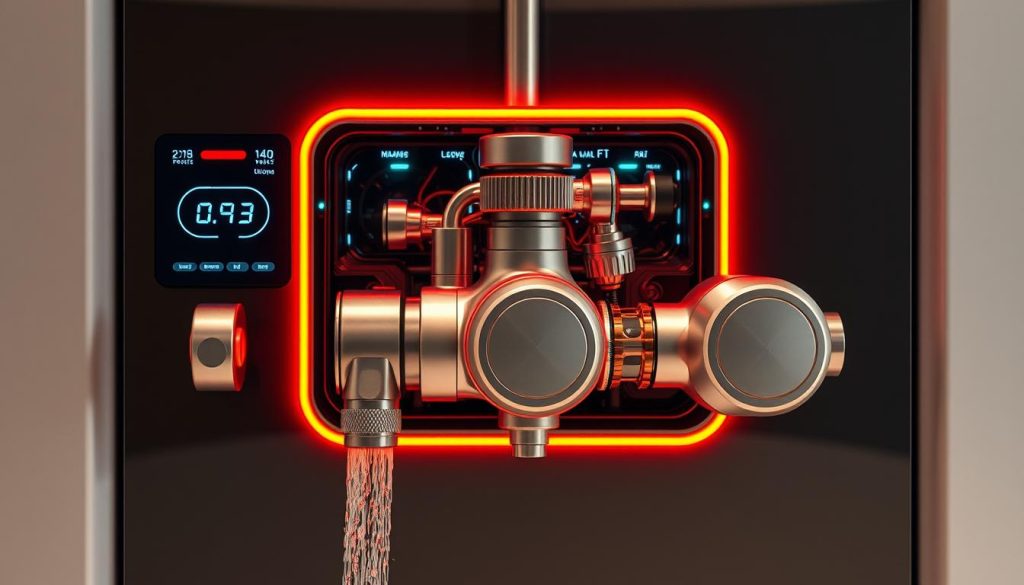
The world of temperature control valves is changing fast. New innovations are making water heater safety valves smarter and more efficient. These changes are affecting how we handle hot water in homes and businesses.
Innovations on the Horizon
The next wave of mixing valves will change how we manage water temperature. They will come with exciting features:
- Built-in intelligent sensors for real-time water quality monitoring
- Advanced temperature precision within ±2°F
- Self-diagnostic capabilities for predictive maintenance
- Enhanced energy efficiency algorithms
Integration with Smart Home Systems
Digital mixing valve technology is leading the way in home automation. Today’s valves offer:
- Smartphone app control for remote temperature adjustments
- Integration with home automation platforms
- Cloud-based monitoring and data tracking
“The future of water temperature management lies in proactive, intelligent systems that prioritize safety and efficiency.” – Plumbing Technology Insights
| Technology Feature | Benefit |
|---|---|
| Real-time Temperature Monitoring | Prevents scalding and bacterial growth |
| Remote Adjustment Capabilities | Enhanced user convenience |
| Energy Optimization Algorithms | Reduces heating costs by 15-25% |
As technology gets better, temperature control valves are becoming more advanced. They offer better safety, efficiency, and control over water heaters.
Conclusion and Final Recommendations
The hot water heater mixing valve is key for home safety and comfort. It helps prevent scalding and bacterial growth. Installing a good mixing valve keeps your family safe and makes your water system more efficient.
Our study shows mixing valves do more than just control temperature. They can increase hot water by up to 50%. This is great for families that use a lot of water. They let you manage water temperature safely and effectively.
Key Insights for Homeowners
Choosing the right mixing valve is important. Think about what your home needs. Always get it installed by a pro and keep it maintained well.
New valve technologies have cool features like thermal disinfection and automatic shut-off. These add extra safety to your home’s water system.
System Evaluation Recommendations
Homeowners should check their water heating setup. Talk to a licensed plumber for advice on installing a temperature control valve. A good mixing valve is a smart investment in your family’s safety and comfort.

